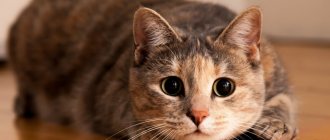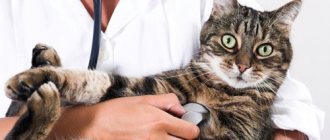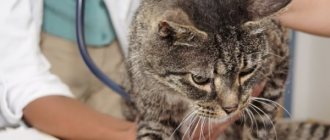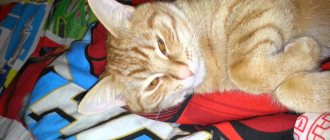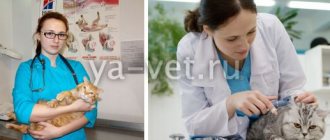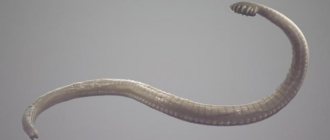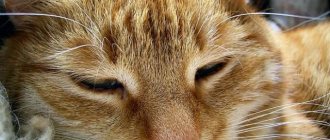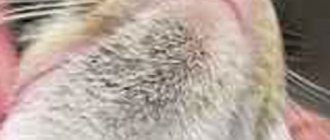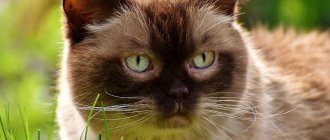What is eosinophilic granuloma in cats?
Feline eosinophilic granuloma is an allergic disease. It is based on the inability of eosinophils (white blood cells) to provide a normal immune response to exposure to an allergen. Eosinophils accumulate in limited areas of the skin or mucous membrane, forming and maintaining a focus of specific inflammation. This is how an eosinophilic granuloma is formed. As the disease progresses, surrounding tissues become further involved in the inflammatory process. When a secondary microbial infection is added, the inflammation intensifies.
Eosinophil dysfunction is congenital. Granuloma most often occurs in cats 3–5 years old. In cats it appears somewhat less frequently. No breed predisposition was identified. Foreign sources carefully mention that Norwegian forest cats may be predisposed to the disease.
Factors contributing to the development of the disease
There are a number of factors that most often trigger the development of the disease:
- allergic reaction to insect bites (ticks, mosquitoes, fleas);
- endoparasites (various helminthiases);
- environmental allergens (plant pollen, plastic bowls);
- allergic reaction to medications;
- fungal, viral infections.
In some cases, there are manifestations of eosinophilic granuloma, and the influence of trigger factors on the cat is excluded. Such cases are considered idiopathic.
Causes
There is no consensus regarding the factors that provoke an increase in the number of eosinophils. The genetic nature of the granuloma has been confirmed; in cats, the tendency to overreact is inherited.
An increased immune response can be primary or secondary - a consequence of congenital pathology or acquired disease:
- atopic diseases (asthma, allergic dermatitis, rhinitis);
- Hernia
Polycystic kidney disease
Anemia
fleas, ticks, lamblia, roundworms and other parasites;
- skin diseases (pemphigus, mycoses);
- sluggish and latent infections;
- long-term medication use;
- diseases of the gastrointestinal tract, joints;
- neoplasms;
- immunodeficiency.
The main cause of eosinophilic granuloma in cats is considered to be a malfunction of the immune system, although not all scientists share this opinion. Perhaps we are talking about some kind of dysfunction in the work of eosinophils themselves, which is genetically determined. The main factors that provoke exacerbation are stress, parasites and allergic reactions.
In most cases, it is not possible to find out what exactly causes the uncontrolled local accumulation of eosinophils, leading to chronic inflammation of the skin or mucous membranes. The primal nature makes complete recovery almost impossible. But symptomatic therapy makes it possible to achieve stable remission in this case as well.
Forms of eosinophilic granuloma
Feline eosinophilic granuloma occurs in a number of forms. They are typical and well recognized by specialists. The following forms are distinguished:
- indolent (flaccid) ulcer;
- eosinophilic granuloma;
- eosinophilic plaque.
Because they are different manifestations of the same allergic disease, they are often called eosinophilic granuloma complex. The forms can be present in one cat either individually or in various combinations. The possibility of transition of granuloma into plaque is noted.
Indolent (flaccid) ulcer
It is characterized by location on one or both upper lips and spread from the skin to the mucous membrane. It looks like an erosion or ulcer with clear boundaries and raised edges. The color is brownish-yellowish, sometimes whitish inclusions of necrosis are noticeable. It doesn't bleed, itch or hurt. The size and depth of the ulcer depends on the stage of the disease. The inflammatory infiltrate causes swelling and deformation of the lip, sometimes damaging surrounding tissues.
Photo gallery: indolent ulcer in cats
An indolent ulcer of the lower lip manifests itself as swelling
With a long-term course of a bilateral indolent ulcer, the cat’s lip becomes deformed
Extensive chronic indolent ulcer involving the upper lips and mucous membrane is accompanied by necrosis and destruction of parts of the lips
Eosinophilic granuloma
Eosinophilic granuloma in the oral cavity appears as whitish nodules and tubercles on the roof of the mouth, tongue, and floor of the mouth. Sometimes their surface is covered with erosions. When localized on the chin, it forms a so-called fatty chin - swelling, hair sometimes falls out and the skin shines. When located on the paws, it is a dense formation that causes severe itching, located in the thickness of the paw pads or in the spaces between the toes. On the sides, abdomen, and lower surface of the thighs it forms very characteristic intradermal thickenings of a linear shape - granulomas. Their color ranges from light pink to yellow-pink. Itching and soreness vary: in some cases they can be pronounced, and in others they can be practically absent.
Photo gallery: eosinophilic granuloma in cats
Linear granuloma of the inner thigh looks like an intradermal thickening
In eosinophilic granuloma, granulomatous masses may appear on the cat's tongue.
Eosinophilic pododermatitis, edema and granulomas with erosion also appear on the paw pads
Eosinophilic plaque
An eosinophilic plaque is an eroded area with clear boundaries that causes severe itching. It rises above the surface of the skin, is moist, shiny and has no hair on it. Any location is possible, but the most typical location is on the abdomen, groin, and inner and back of the thighs. Adjacent lesions may merge, increasing the eroded surface area. The painfulness of the eosinophilic plaque is described by the authors as unexpressed, but it is absolutely certain that with infection and inevitable scratching, the pain will become distinct.
Photo gallery: eosinophilic plaque in cats
The typical location of an eosinophilic plaque is on the inner thigh. A group of small eosinophilic plaques tend to coalesce. Eosinophilic plaques usually appear in cats on the abdomen, groin, and thighs.
Symptoms
The symptoms of eosinophilic granuloma are varied. These include :
- Tissue swelling.
- Formation of dense nodules or small ulcers on the skin.
- Skin lesions are most often single in nature.
- In the animal’s oral cavity – on the palate or tongue – pimples (papules), nodules, and plaques appear that interfere with normal swallowing. This phenomenon is called dysphagia, it leads to chronic starvation of the cat and can cause serious complications, including liver lipidosis.
- Sometimes lumps appear, accompanied by itching, but not causing pain.
- Lymph nodes in cats are enlarged.
Most often, an animal with a granuloma does not show any concern and behaves as usual, especially if the inflammation is just beginning and does not cause itching. Therefore, the owner is required to be attentive to his pet.
© shutterstock
Having discovered at least one of the manifestations of granuloma, you should immediately visit a veterinarian and begin treatment, because the sooner this is done, the greater the cat’s chances for a successful outcome without complications.
General symptoms of eosinophilic granuloma
Signs of the disease are determined by several factors:
- the degree of activity of the allergic process and the duration of its course;
- the severity of signs of secondary, already bacterial inflammation;
- trigger factors, for example, the manifestation of a fungal infection of the skin or scabies.
General symptoms are not specific. The following manifestations are possible:
- reaction of regional lymph nodes: if at the beginning of the disease it is absent or a slight change in the lymph nodes is observed, then with the development of the disease, an increase in the affected area and the addition of bacterial flora, the lymph nodes enlarge, become dense, painful, and merge into packets;
- development of purulent lymphadenitis in severe cases: with the development of intoxication accompanying bacterial inflammation, an increase in body temperature, lethargy, deterioration in the cat’s appetite and activity is possible;
- loss of body weight due to impaired chewing and swallowing with localization of granulomatous growths in the mouth, eosinophilic lesions of the digestive tract or chronic intoxication with pyoderma;
- specific damage to the digestive system with a long course of the disease and lack of treatment - the development of eosinophilic gastritis and enteritis;
- in advanced cases - enlargement of the liver, spleen, peripheral lymph nodes that are not regional to the granuloma focus;
- In laboratory tests, eosinophilia in the peripheral blood of up to 20% always attracts attention; there may be a decrease in total protein; with a long course of the disease, hypergammaglobulinemia is observed in the proteinogram, and some authors point to a persistent increase in amylase levels.
What it is?
To summarize, we can say that this term refers to a wide group of inflammatory diseases of the skin of animals. There are various clinical forms, in many cases differing significantly in the nature of their course, but nevertheless an inflammatory reaction is almost always observed. Most often, the skin is affected on some part of the body, as well as the oral cavity (pictured).
Initially, it was believed that this disease could be initiated by dozens of reasons, including parasites, poor-quality food, stress and environmental influences, but today scientists are inclined to think that in almost all cases granuloma is a peculiar manifestation of a local and general allergic reaction. In most cases, skin lesions are very itchy, and therefore the animal constantly licks and scratches them.
Often this pathology is one way or another associated with flea dermatitis. Since owners for a long time do not attach any importance to the constant licking of their pet, the disease can go very far.
Possible consequences and complications, prognosis
If the cat does not receive treatment at the stages of local manifestation of the disease, allergic miliary dermatitis and eosinophilic gastritis may develop, which reflect the increased involvement of dysfunctional eosinophils in the pathological process:
- Allergic miliary dermatitis, or eczema. It manifests itself as tiny, millet-like rashes in the form of bubbles and tubercles throughout the body, redness of the affected areas, and intense itching. Characteristic is the formation of tiny erosions, then scabs that merge. The fur thins and falls out. In the chronic course of the disease, areas of redness are replaced by dark pigmentation, and acanthosis nigricans is formed. There is a high risk of infection when scratching and the development of secondary pyoderma. In common parlance the condition is called scab.
- Eosinophilic gastritis and enteritis. Eosinophils infiltrate the walls of the stomach and small intestine. The intestinal loops are thickened and dilated. Animals lose weight, the stool is not formed, often mixed with blood. Frequent vomiting is possible.
The most typical complication is secondary pyoderma - infection and suppuration of the affected areas. Its signs:
- cloudy discharge appears, pain increases;
- swelling and redness spread to surrounding tissues;
- body temperature rises;
- the reaction from the regional lymph nodes is expressed in the form of their enlargement and pain on palpation;
- The cat’s general health deteriorates due to increasing intoxication.
The prognosis for cats in which the allergen has been identified and contact with it can be eliminated is favorable: the disease goes away without a trace after treatment. In other cases, long-term and repeated therapy and frequent outpatient monitoring will be required. Lack of response to treatment, as well as the occurrence of adverse reactions to therapy worsen the prognosis. Veterinary care increases the period of remission to 6–8 months, improves the quality of life, and also maintains its duration at the usual level for cats.
What causes
Modern science has dismissed the following reasons as the causative agent of the disease:
- parasites;
- food of inadequate quality;
- environmental factors;
- stress.
Did you know? The mass extermination of cats, recognized during the Inquisition as accomplices of the devil, led to a disruption of the natural balance and the spread of rats in Europe, which are carriers of the plague, outbreaks of which periodically significantly devastated medieval Europe.
At this time, veterinary thought is inclined to believe that eosinophilic granuloma is caused by autoimmune mechanisms, and it is a consequence of pathological processes that occur in the animal’s body, and not an independent disease. Basically, scientists are of the opinion that the disease develops as a result of the activity in the pet’s body of special leukocytes - eosinophils, the purpose of which is to block the path to viral and bacterial damage to the body.
Factors contributing to the development of an infectious disease are:
- the animal's tendency to allergic reactions;
- existing hypersensitivity;
- the cat's body's reaction to food;
- flea or tick dermatitis;
- a tendency inherited by a pet.
Diagnosis of feline eosinophilic granuloma
Given the characteristic manifestations, competent cat owners will undoubtedly suspect eosinophilic granuloma. This will have the advantage of early contact with a veterinarian. It is impossible to make a diagnosis on your own. To do this, an examination, medical history and a set of laboratory tests are carried out. But it is also necessary to exclude diagnoses with similar manifestations. Only then, based on the results obtained, do they begin to choose therapy.
Diagnosis begins with collecting anamnesis:
- It is established when the first manifestations of the disease appeared, what they looked like, what preceded it, and whether there is a hereditary predisposition to pathology of the immune system.
- The presence of infestations of worms, fleas, ticks, as well as fungal and viral infections is clarified.
- The diet is analyzed and the impact of external allergic factors is studied.
- The doctor searches for and isolates the trigger - the factor that started the disease. We need to pay close attention to this. To search for an allergen in the external environment, skin allergy tests are used.
After this, it is necessary to exclude diseases with similar symptoms:
- tumors, especially squamous cell carcinoma;
- skin lupus;
- viral, fungal, mycobacterial infections;
- drug reactions;
- burns from caustic substances;
- bites from other animals;
- thermal damage.
To verify the diagnosis, a dermatological examination of the skin is performed. Volumetric granulomatous formations are examined using fine-needle aspiration biopsy. Material from ulcerative defects is collected by scrapings. In the cytological material of eosinophilic granuloma, many eosinophils and histiocytes are detected. You can also do a bacteriological culture to determine sensitivity to antibiotics, if necessary.
It is impossible to independently determine the presence of eosinophilic granuloma; the help of a veterinarian is required
The doctor takes blood for general and biochemical analysis. There are no manifestations specific to granuloma, but analysis is required to collect information about the functional state of the cat’s body, as well as to identify metabolic disorders - renal failure, diabetes mellitus, liver failure. This, of course, reduces the doctor’s therapeutic arsenal, but protects the cat from complications of therapy. If necessary, the veterinarian prescribes a urine test and an ultrasound of internal organs.
Diagnostics
Diagnosis of eosinophilic granuloma consists of several stages and makes it possible to distinguish pathology from dermatological and oncological diseases with similar symptoms.
- Visual inspection. The doctor conducts a detailed examination of the skin lesions using special magnifying glasses and other devices.
- Anamnesis collection. Anamnesis collection is carried out in order to identify provoking factors that can cause an allergic reaction in the body. The owner is asked questions regarding the cat’s diet and living conditions, and he must talk in detail about all aspects of the pet’s life.
- Smear collection. After collecting an anamnesis and an external examination, the veterinarian takes a smear-imprint from the surface of the ulcers onto a glass slide, stains it with special substances and examines it under a microscope. The method allows you to determine the presence and type of pathogenic microorganisms that may be present on the surface of the skin, as well as detect eosinophils - a high concentration of these cells in the sample confirms the diagnosis.
- Blood tests. The study helps detect increased levels of eosinophils and other signs of the inflammatory process.
- Tests to identify parasites. They are carried out to identify fleas, worms and other parasites that can provoke pathological reactions in the body.
- Allergy tests. Intradermal tests to detect allergic reactions to various environmental factors.
- Biopsy. Tissue sampling is necessary when tumor processes are suspected, and is prescribed in cases where mast or giant cells are found in eosinophilic plaques, ulcers and papules.
To make a diagnosis, a comprehensive examination of the cat is necessary.
Attention! Treatment for a cat with eosinophilic granuloma can be prescribed only after a comprehensive diagnosis - the symptoms of the disease resemble manifestations of other pathological processes of an infectious, non-infectious or malignant nature.
When to urgently contact a veterinarian
An urgent visit to the veterinarian is necessary:
- if the presence of eosinophilic granuloma is suspected: the sooner the doctor sees the cat, the simpler the treatment and the better the prognosis;
- if there is no effect from the treatment within the expected time frame, the previous size of the damage, pain, itching remain: perhaps the treatment was not suitable;
- when signs of inflammation appear or intensify: opportunistic bacterial flora may join;
- when side effects and complications of treatment develop, they are usually warned about when prescribing one or another type of therapy;
- if there is a change in the cat’s health condition associated with the action of extraneous factors, for example, accidental poisoning with vomiting during treatment with tablets: therapy cannot be interrupted; in order to change the dosage form of the drug, you should consult a doctor;
- for any negative change in the cat's health status.
The secretive nature of the behavior of cats does not allow one to suspect skin diseases in the early stages, and intensive grooming (active behavior of animals aimed at cleaning the surface of the body) is usually not perceived by the owner as a pathology in his pet... The owner of an animal often sees such “defects” on the body of a pet panics... and decides to euthanize the animal. However, most erosive and ulcerative dermatoses of cats respond well to therapy, even with delayed diagnosis.
A.N. Gerke, Ph.D., veterinarian at ZAO Chain of Veterinary Clinics, St. Petersburg
https://cyberleninka.ru/article/n/erozivno-yazvennye-porazheniya-kozhi-u-koshek-diagnostika-i-lechenie
Surgical treatment of feline eosinophilic granuloma
Since eosinophilic granuloma is a systemic disease, priority remains with drug therapy. Surgical treatment is indicated in case of treatment-resistant single large plaques and granulomas. This may be excision with a scalpel, laser evaporation or cryodestruction. Relapses are often observed during surgical treatment. Before surgery, it is advisable to sanitize the plaque with antiseptic solutions to prevent the spread of infection to surrounding tissues during manipulation.
Diagnosis of the disease
Granuloma in cats develops quickly. Timely diagnosis is 50% of success. You should not self-medicate. As soon as anxiety or external signs of the disease become noticeable, you need to consult a specialist. The veterinarian will take blood tests from the cat and determine the cause of the concern. Additional analysis - biopsy and blood cytology will determine whether the ulcer is a malignant neoplasm.
Distemper in cats: symptoms and treatment at home
In addition, the doctor will test for allergens.
Important! If you decide to buy an animal from a cattery, you need to ask for cards of the kitten’s parents. It is necessary to check whether his parents have a predisposition to granuloma.
A person who does not have a veterinary education may mistake the disease for a fungus. For this reason, it is not recommended to self-medicate your cat.
Treatment of feline eosinophilic granuloma at home
Treatment at home consists solely of following the veterinarian’s prescriptions. The following recommendations are usually given:
- at the very beginning of treatment, protect the cat from self-harm by scratching and licking: provide soft polymer claw covers, protective overalls, and a protective “Elizabethan” collar;
- if a triggering factor has already been identified, then protect the cat from its influence, for example, from mosquito bites;
- give the animal medications prescribed by a veterinarian;
- carry out local treatment using solutions and ointments as prescribed by the veterinarian;
- provide special feeding for the cat (relevant for food allergies or underweight);
- monitor the cat’s condition over time;
- Bring your cat to the veterinarian for checkups.
To avoid scratching and infection of skin lesions, use a protective collar.
Anti-inflammatory and immunosuppressive therapy
If the disease was noticed late, then steroid therapy will only worsen the pet’s condition. If the treatment does not bring a positive effect, the doctor prescribes immunosuppressants. With the help of these drugs, the body activates and fights the disease on its own.
When prescribing immunosuppressants, the specialist must warn about possible complications, since treatment takes place after the use of hormonal therapy.
Treatment regimen with dosage calculation:
- Cyclosporine no more than 5 milligrams per day per kilogram of cat’s weight;
- Chlorambucil no more than 0.1 milligram per day per kilogram of cat’s weight;
- Solganol in injections. No more than 1 milligram per day per kilogram of cat’s weight.
Additional treatment includes adding vitamins and omega-3s to the cat's diet. The vitamin complex will help restore the integrity of the animal’s skin.
If the therapy does not produce the expected results, the doctor may prescribe a laser procedure. The affected area of the cat's skin is cauterized with a laser so that the affected area does not increase in the future.
There is no generally accepted treatment algorithm for cats. The doctor selects treatment based on age, gender, health and degree of disease.
Important! It is possible to cure eosinophilic syndrome in cats with strict adherence to the rules of care and drug treatment.
Drug treatment of feline eosinophilic granuloma
In drug treatment, the following areas are distinguished:
- etiotropic therapy - aimed at eliminating the factor that caused the allergy, for example, treatment of demodicosis or deworming;
- anti-inflammatory, immunosuppressive therapy - suppression of the pathological reaction of the immune system;
- antibacterial therapy - prescribed if there is a secondary bacterial infection;
- symptomatic therapy - aimed at improving the functioning of organs;
- local therapy - applying solutions and ointments directly to the skin.
Depending on the situation, the veterinarian combines directions, creating an individual treatment program for each cat. Medicines used for etiotropic and symptomatic therapy are varied, and the composition of medicines for anti-inflammatory, antibacterial and local therapy is constant.
Anti-inflammatory and immunosuppressive therapy
Two types of medications are used:
- Corticosteroids. They provide rapid anti-inflammatory, anti-edematous and antipruritic effects, reduce cellular infiltrates in areas of inflammation and block the release of inflammatory mediators by cells. Applicable:
- prednisolone tablets 1-2 mg/kg every 12-24 hours, followed by a gradual increase in the interval to 48-72 hours - it is important to continue treatment even after the signs of granuloma disappear for at least a week;
- analogues of prednisolone in tablets: methylprednisolone (0.8 doses of prednisolone);
- dexamethasone (0.15 doses of prednisolone);
- triamcinolone (0.25–0.8 doses of prednisolone);
- injectable forms of corticosteroids (effective, the effect appears within the next 24–48 hours and lasts from several days to weeks, but the risk of developing immunosuppression and diabetes mellitus when using long-acting forms is higher than when taking tablets):
- dexamethasone subcutaneously, intramuscularly (Dexafort 0.3 - 0.7 ml per cat);
- methylprednisolone acetate intramuscularly (Depo-Medrol 0.25 - 0.5 ml per cat);
- triamcinolone (Kenalog IM 0.2 – 0.5 ml per cat).
- Cytostatics (immunosuppressors). If manifestations of eosinophilic granuloma return when the dose and frequency of administration of corticosteroids is reduced, then they switch to combination therapy with cytostatics. Their action is aimed at inhibiting pathological cell division. When using them for granuloma, they hope to suppress the formation of eosinophils in the bone marrow. They are characterized by side effects from the digestive system (nausea, vomiting, diarrhea), as well as from bone marrow hematopoiesis (platelets are the first to suffer). Therefore, you need to carefully monitor the cat’s condition and prepare to take control blood tests. It is important to have time to cancel therapy if complications begin to develop. Used:
- chlorambucil in doses of 0.1–0.2 mg/kg (2–4 mg/m2 body surface) daily or every other day, symptoms of gastrointestinal tract damage - anorexia, vomiting, diarrhea - occur less frequently when prescribed every other day, and depression hematopoiesis disappears after discontinuation of the drug (the course is 1–2 months, then the dose is reduced until the drug is discontinued);
- cyclosporine at a dose of 2.5 mg/kg/day - when a response to therapy is achieved, the dose is successively reduced until completely discontinued.
When treating eosinophilic granuloma, veterinarians prescribe prednisolone in the form of tablets or injections.
The selection of a corticosteroid should be based on its effectiveness in a particular cat. When treating animals with drugs of this group, it is recommended to monitor the clinical blood test, including platelet count, every 2 weeks.
Table: cost of different types of corticosteroids
| A drug | Prednisolone 5 mg No. 100 (Gedeon Richter) | Methylprednisolone 4 mg No. 30 (Metypred, Orion) | Dexamethasone 0.5 mg No. 10 (KRKA) | Triamcinolone 4 mg No. 50 (Polcortolone, Polfa) |
| Price at the pharmacy, rubles | 108 | 201 | 45 | 356 |
| Cost of treatment for one day of a cat weighing 5 kg in a therapeutic dose, rubles | 2,16 | 13,4 | 13,5 | up to 14.24 |
The most affordable drug is Prednisolone. Its advantage is the presence of a dosage of 1 mg, since maintenance dosages lower than therapeutic ones are inconvenient. When comparing prices for injectable long-acting corticosteroids, the price of a dose in milliliters or an ampoule is taken. The contents of the ampoule are not stored after taking the required amount of the drug.
Table: prices of injectable corticosteroids
| A drug | Dexafort 50 ml | Depo-Medrol 1 ml No. 1 | Kenalog 1 ml No. 5 |
| Price at the pharmacy, rubles | 1073 | 77,5 | 450 |
| Price of a dose or ampoule, rubles | 15,022 | 77,5 | 90 |
An opened bottle of Dexafort is stored for 28 days, after which it is disposed of along with the contents.
Antibacterial therapy
When skin manifestations of eosinophilic granuloma become infected, which is promoted by itching followed by scratching, as well as chronic ulcers, systemic antibacterial therapy is required. Broad-spectrum antibiotics are used:
- amoxicillin + clavulanate - 12.5–25 mg/kg po every 12 hours;
- cephalexin - 25 mg/kg po every 12 hours;
- enrofloxacin - 5–10 mg/kg po every 12 hours;
- other drugs.
In chronic cases, suspected resistance to antibacterial therapy, as well as the development of opportunistic flora, the material is sent for microbiological testing (isolation of bacterial and fungal cultures and antibiotic sensitivity testing).
Chronic ulcers should be treated with antibiotics such as Cephalexin
Local therapy
Has auxiliary meaning. It consists of applying antiseptic solutions (Miramistin, Povidone-iodine, aqueous solution of Chlorhexidine), as well as ointments containing corticosteroids, to skin lesions. Without systemic antibacterial therapy, only erosions are eliminated by local exposure.
Treatment of the disease and prognosis
Only a clear definition of the cause that caused the development of granuloma will help select the correct treatment and determine how quickly the animal will recover. Most often, the disease is idiopathic in nature and symptomatic treatment is used to eliminate it. A similar method of therapy can be used during a seasonal exacerbation, even when the pet is under long-term treatment.
Local therapy if an animal has an eosinophilic granuloma does not make sense. This requires the use of systemic drugs. It is mandatory to use insecticides to eliminate parasites, regardless of their presence on the animal’s skin. Only after complete antiparasitic treatment is it possible to begin anti-inflammatory therapy.
Most often, veterinarians recommend the use of hormonal steroids:
- Prednisolone;
Anti-inflammatory therapy may be the use of Prednisolone
- Dexamethasone;
Dexamethasone can also be used to treat eosinophilic granuloma in cats.
- Triamcinolone.
Giving your pet tablets is allowed for no more than 3 weeks. If it is difficult for the owner to give pills to the cat, then they can be replaced with intramuscular injections. In this case, the medicine is administered twice at intervals of a week. After the main symptoms of the disease disappear, the dosage of the medication is reduced, and then the use of the medication is completely discontinued. If the cat has a large eosinophilic plaque, the doctor will give a single injection of Triamcinalone into the plaque.
As an additional treatment, Omega 3 should be added to food. Allerderm Spot-On is applied to the withers in the affected area. It is also recommended to replace the cat’s daily diet with hypoallergenic food from well-known manufacturers. You should not prepare protein meals and feed your pet yourself - this can aggravate the situation. It is recommended to introduce food under the Anallergenic brand into your pet’s diet.
It often happens that surgery is required to remove the affected area of skin. In this case, the doctor selects the optimal method of surgery. Cryotherapy and the use of laser are considered safer. After this procedure, the pet will recover quickly. But surgical intervention must be combined with an anti-inflammatory complex of drugs.
It is very difficult to predict the recovery of an animal when diagnosing eosinophilic granuloma. This will be influenced by several factors:
- the reason for the development of the pathology is that if you exclude the animal’s interaction with the allergen, it will quickly recover;
- age and health of the pet - in kittens and older cats the likelihood of death is much higher than in adult animals;
- degree of damage to the body;
- timely detection of the disease;
- properly selected treatment.
The risk of death of the animal increases when the disease is detected in kittens and old cats. In this case, therapy is often useless. In other cases, the likelihood of recovery is high. To increase the likelihood of a favorable treatment outcome, the following recommendations should be followed:
- If there is a rash on the animal’s skin, immediately switch it to a hypoallergenic diet.
- The diet should continue throughout the entire treatment period.
- Add vitamins and mineral supplements to your pet's diet.
- When starting treatment, you need to carefully monitor the animal’s condition. At the first signs of intolerance, you should consult a doctor and stop using the medication.
- For older cats, the treatment period should be extended by 2 weeks. A weakened body needs more time to recover.
If you follow these rules, recovery will come much faster. In addition, this approach will prevent the development of a secondary infection.
I personally have not encountered this disease in my pets, but I have seen granuloma in my godmother’s cat. We were unable to save her - the cat was pregnant, was capricious and refused to eat. When they realized that something was wrong, it was too late. Prednisone injections prolonged her life by just a few days and relieved some of the pain. Since then I have been closely monitoring how my pet feels.
Are folk remedies used in the treatment of eosinophilic granuloma?
It is strictly forbidden to use any means, including folk remedies, that have not been approved by a veterinarian. An additional allergic load on the cat’s body, which is already in a state of pathological excessive immune response, is unacceptable. In the best case, nothing will happen; in the worst case, the immune response may expand, for example, miliary dermatitis will join the indolent ulcer. This will significantly worsen the cat’s condition, complicate treatment and worsen the prognosis of the disease.
How to treat a sick cat
Since the manifestations of eosinophilic granuloma are associated with systemic reactions of the body, and not with damage to the skin, the use of ointments, creams and other local remedies is not advisable. The basis of treatment is hormonal drugs:
- Dexamethasone (0.3 mg/kg per day));
- Prednisolone (2 mg/kg);
- Triamcinolone (0.8 mg/kg).
Steroids are taken in tablet form or administered subcutaneously, and the course of treatment should not exceed 3 weeks, and the exact dosage and frequency of use is determined by the doctor. As the skin lesions disappear, the dosage of the drugs is reduced and then discontinued completely.
Eosinophilic granuloma is treated with steroid hormones
Symptomatic medications (local drops and ointments that reduce itching), vitamins and antiparasitic agents are used as additional treatment.
Rules for caring for a sick animal
The main thing in care is to reliably protect the cat from the action of factors that trigger immune restructuring. It is important to carefully follow the regimen of giving medications (corticosteroids are given at the same time), taking control tests and visiting the veterinarian. In addition, do the following:
- replace the litter in the cat’s tray with a hypoallergenic one, as well as its dishes and bed;
- protect the cat from self-harm, feed it properly, keep the room and the cat clean;
- Treat your cat against fleas, ticks, and helminths;
- limit the cat’s freedom of movement if it is on a self-walk - this will protect the cat from eating found food, repeated infections with fleas, worms and ticks, as well as from disruption of the medication regimen;
- watch the cat, keep a diary, take photographs;
- treat skin lesions with ointments or antiseptic solutions.
When caring for a cat with eosinophilic granuloma, treatment for helminths, fleas, and ticks is carried out.
Thus, with correct diagnosis and, if possible, frequent outpatient monitoring, in many cases it was possible to improve life and increase the period of remission to 6–8 months. Most cats are still living or have managed to live to be 12–16 years old.
FGOU VPO SPb GAVM (St. Petersburg), Veterinary Clinic Pet (Pushkin)
vetpushkin.rf/minikatalog/i/eozinofilniy-sindrom/
Diet
Nutrition is of great importance, because in cases where the granuloma is caused by a food allergy, the diet takes on the importance of etiotropic therapy and its observance ensures the cure of the cat. In this case, it is better to use hypoallergenic veterinary food from trusted manufacturers: Royal Canin, Hills and others. If the cat is on natural feeding, then it should receive food that it has not received before. For example, the first week - rabbit meat, the second - elk, the third - turkey, the fourth - lamb. All this time the cat should be monitored. Limiting fat in your cat's diet is important because pancreatitis can easily occur during corticosteroid therapy. Under no circumstances should you give your cat food from the table. Cats who are ill for a long time may develop a body weight deficit: their food should contain a sufficient amount of protein - meat, fish, poultry, low-fat cottage cheese.
Eosinophilic plaque
This form can affect cats of any age. Externally, eosinophilic plaque manifests itself in the form of baldness with redness of the skin. Severely itchy sores and rashes usually form on the affected areas. Bald patches with this form usually appear on the neck, hips and back of the animal. In most cases, they progress over time.
Features of treatment of pregnant cats and kittens
Taking corticosteroids, cytostatics and antibiotics is incompatible with pregnancy and breastfeeding. The right decision would be to sterilize the sick animal. If your cat is already pregnant, you should check with your veterinarian to see if it is possible to delay therapy until delivery. Next, you will have to resolve the issue of breastfeeding kittens. Here the doctor will assess the cat's health and the risks of starting therapy later, and perhaps he will allow feeding. Otherwise, the kittens will have to be fed artificially or with the help of another lactating cat. A sick pregnant cat must be observed by a veterinarian, since it is important to exclude the influence of the triggering factor of the allergy. For example, if it is a nutritional factor, then switching to a hypoallergenic diet will significantly improve her condition. Of course, the doctor will not be able to prescribe most of the medications, but he will find other ways to help the cat. Eosinophilic granuloma is not typical for kittens, since for its development there must be prolonged contact with the allergen. Kittens prone to developing this disease may develop allergic reactions from childhood that cannot be ignored.
If a mother cat has eosinophilic granuloma, the kittens are most often artificially fed
Possible causes of the disease
There is still no single version about the causes of this disease. But all doctors agree that two factors have an influence:
- heredity;
- weak cat immunity;
- sensitivity due to breed.
Mycoplasmosis in cats: treatment, danger to humans
When two factors are combined, the risk of developing the disease increases. The development of the disease can be triggered by an insect bite or pollen falling on an area with an open wound.
The disease is not contagious and does not pose a danger to cats that are not infected.
Cats of artificially bred breeds that are highly sensitive to allergens and parasites are prone to the occurrence of eosinophilic granuloma.
Important! Owners of females are more likely to encounter granuloma than owners of males. The fact is that the cat’s body, prone to hormonal changes, is more vulnerable to disease.
The disease manifested in a kitten leads to death in 90% of cases, since the immune system is not strong enough to fight the disease.
Prevention
The main thing is to prevent the development of an allergic reaction in cats. If it already exists, every effort must be made to identify its source and isolate it from the cat, since eosinophilic granuloma is an extreme manifestation of the body’s hypersensitivity and it once began with a simple allergic reaction. Be sure to show your cat to a veterinarian, who will prescribe a course of treatment to stabilize the immune system and reduce the further risk of developing eosinophilic granuloma. It is important to treat your cat against fleas, ticks, helminths, as well as timely treatment of fungal and viral infections. Preventative examinations by a veterinarian are of great importance, since some allergic reactions in cats may occur unnoticed by the owners, but the doctor will definitely pay attention to them. Compliance with the general rules of keeping a cat combined with attention to its health is already an effective protective factor.
Disease prevention
There are no targeted preventive measures to eliminate the risk of developing the disease due to the fact that the exact pathogen has not been identified. But there are a number of measures that, if observed, can reduce the likelihood of infection:
- limit consumption of foods that may cause allergies;
- if an animal is found to have an increased risk of developing allergies, it should be fed only with hypoallergenic food;
- regularly introduce vitamins and minerals into your pet’s diet;
- bathe and comb the cat, treat it with antiparasitic drugs;
- Be regularly examined by a veterinarian for inflammation and infections.
A timely detected disease is much easier to treat than an advanced form. Therefore, you need to carefully monitor the health of your pet. If the animal has been ill, then its immunity should be strengthened to avoid relapse. Regular visits to the veterinarian and timely vaccination will help avoid the development of inflammation in the future.
Drugs for the treatment of dermatitis in cats caused by EEG
Treatment is aimed primarily at finding out the cause and bringing it under control. Symptomatically used drugs to reduce itching are steroids (for example, Prednisolone) or Cyclosporine. For deep ulcers and secondary infection, antibiotics may be required.
The situation is strictly individual in each case, therefore, if the symptoms listed above appear, you should absolutely not self-medicate. It is imperative to consult a veterinarian to make a correct diagnosis. After all, even what outwardly looks like an EEG can turn out to be a more serious disease, even a malignant tumor.
Treatment
Therapy for eosinophilic granuloma depends on the degree of development of the disease and the factor that caused it. In some cases, when the allergen has been classified and its effect has ceased, several treatments of the affected areas with external preparations that relieve inflammation and itching are sufficient. For this purpose, ointments, gels or sprays based on glucocorticoids are usually used: Prednisolone, Dexamethasone, Methylprednisolone.
To reduce allergic manifestations, the cat can be prescribed antihistamines: diphenhydramine, tavegil, diazolin, claritin, cetirizine. If the cause of the disease is autoimmune in nature, immunosuppressants are prescribed - Chlorambucil or Cyclosporine. In cases where the disease is severe and there is a risk of infection, the veterinarian may prescribe a course of antibiotics (Amoxicillin, Lincomycin, Gentamicin, Cobactan) in the form of injections or ointments to treat the affected areas.
Attention! Usually, significant improvements are noticeable within 1-1.5 weeks after the start of therapy, but treatment must be continued for at least 3-5 weeks, gradually reducing the dosage of the drugs. Older cats often require a longer course of treatment, sometimes up to 8 weeks.
After your pet has fully recovered, the doctor may prescribe a course of maintenance therapy: for several months the cat will need to add vitamins and minerals to its food; the most suitable option for such a complex is selected individually.
A mandatory component of the treatment of granuloma in cats is a hypoallergenic diet. If food for an animal is prepared at home, the diet should contain approximately 80% meat products. It is recommended to use boiled meat and poultry by-products. The remaining 20% is cereals (rice, buckwheat, oats), vegetables and vegetable fats. There should not be a lot of animal fats on the menu; they can cause an allergic reaction.
If your cat eats canned food from jars or pouch bags and dry kibble, he will need a special category of ready-made food during the period of treatment for eosinophilic granuloma. The packaging of such food must include the inscription “diet for cats with allergies.” Hypoallergenic food is produced by many pet food manufacturers. Veterinarians consider the products of Bosch Sanabel “HAIR & SKIN” and Royal Canin “Sensitivity Control Feline” to be some of the best therapeutic and dietary canned food and kibble for cats.
